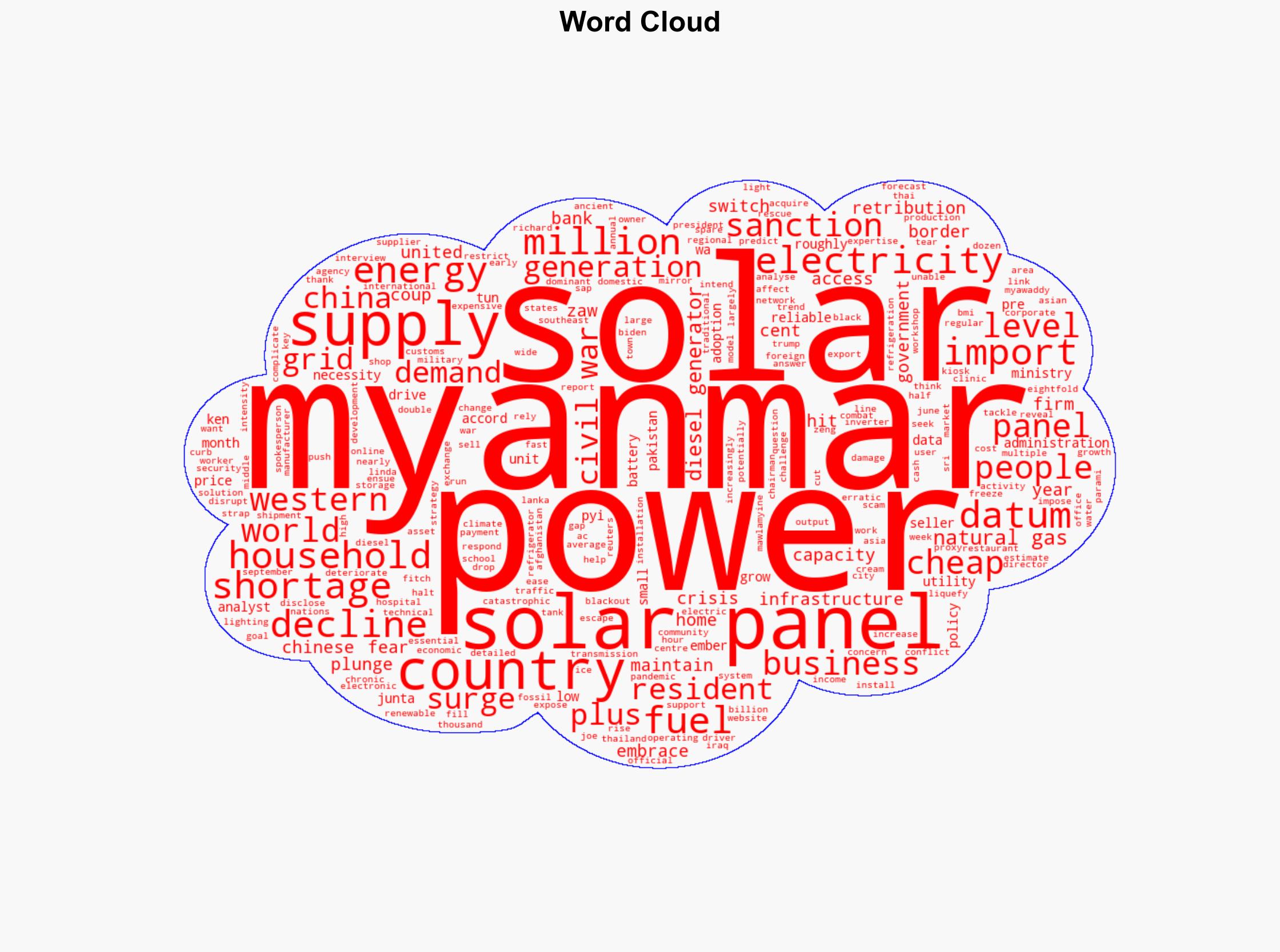War-torn Myanmar embraces solar to tackle power crisis – CNA
Published on: 2025-11-14
AI-powered OSINT brief from verified open sources. Automated NLP signal extraction with human verification. See our Methodology and Why WorldWideWatchers.
Intelligence Report: War-torn Myanmar embraces solar to tackle power crisis – CNA
1. BLUF (Bottom Line Up Front)
With a medium confidence level, it is assessed that Myanmar’s shift towards solar energy is a pragmatic response to its acute power crisis exacerbated by political instability and international sanctions. The most supported hypothesis is that Myanmar’s adoption of solar energy is primarily driven by necessity rather than strategic energy policy reform. Recommended actions include monitoring the impact of increased solar adoption on Myanmar’s socio-economic stability and exploring diplomatic channels to support sustainable energy development.
2. Competing Hypotheses
Hypothesis 1: Myanmar’s adoption of solar energy is a strategic shift towards sustainable energy to mitigate long-term energy security risks.
Hypothesis 2: The shift towards solar energy is a short-term, reactive measure to address immediate power shortages due to the deterioration of traditional energy infrastructure.
The evidence, such as reliance on Chinese solar imports and the lack of government-led strategic initiatives, supports Hypothesis 2 as more likely. The shift appears driven by necessity due to infrastructure collapse rather than a coordinated energy policy shift.
3. Key Assumptions and Red Flags
Assumptions: It is assumed that Myanmar’s government lacks the capacity to restore traditional power infrastructure in the near term. Additionally, it is assumed that international sanctions will persist, limiting access to traditional energy resources.
Red Flags: The possibility of retribution against those adopting solar energy suggests potential internal resistance or conflict over energy resources. The rapid increase in solar imports from China could indicate over-reliance on a single supplier, posing a strategic vulnerability.
4. Implications and Strategic Risks
The shift to solar energy could lead to increased economic resilience in some communities, reducing the immediate impact of power shortages. However, over-reliance on imported solar technology from China may create new dependencies. Politically, the junta may face challenges if solar adoption empowers local communities and reduces their reliance on state-controlled energy sources. Economically, the lack of infrastructure investment could hinder long-term growth.
5. Recommendations and Outlook
- Encourage international cooperation to support Myanmar’s energy transition with sustainable practices and diversified energy sources.
- Monitor the socio-political impact of solar adoption to anticipate potential shifts in power dynamics within Myanmar.
- Best-case scenario: Solar adoption leads to increased energy independence and economic stability.
- Worst-case scenario: Over-reliance on solar imports leads to strategic vulnerabilities and economic stagnation.
- Most-likely scenario: Incremental improvements in energy access with continued socio-political challenges.
6. Key Individuals and Entities
Zaw, a rescue worker in Myawaddy town, represents local adoption of solar energy. Ken Pyi Wa Tun, chairman of Parami Energy, is a key figure in the solar market.
7. Thematic Tags
Regional Focus: Southeast Asia, Energy Security, Political Instability, Economic Resilience
Structured Analytic Techniques Applied
- Causal Layered Analysis (CLA): Analyze events across surface happenings, systems, worldviews, and myths.
- Cross-Impact Simulation: Model ripple effects across neighboring states, conflicts, or economic dependencies.
- Scenario Generation: Explore divergent futures under varying assumptions to identify plausible paths.
- Network Influence Mapping: Map influence relationships to assess actor impact.
Explore more:
Regional Focus Briefs ·
Daily Summary ·
Methodology





